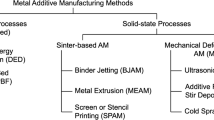Abstract
In this study, A7204-T4 aluminum alloy sheet with a thickness of 6 mm was welded using fiber laser variable polarity tungsten inert gas (VPTIG) hybrid welding with ER5356 filler wire, during which Nb (niobium) foils with different thicknesses (10 μm, 25 μm, 35 μm, and 50 μm) were preset between the butt joint faces. The joint microstructure and properties with different Nb content were investigated in detail. According to the results of this study, the welds after Nb micro-alloying exhibited significantly reduced pores, while Nb-concentrating phases and the NbAl3 precipitated phase gradually appeared and acted as heterogeneous nucleation particles, which can refine the grains. Therefore, columnar crystals and secondary dendritic crystals at the weld center disappeared and fine equiaxed crystals appeared. After the addition of 10 μm Nb foil in the hybrid welding, the micro-hardness of weld metals was significantly enhanced, heat-affected zone in the weld joint became narrower, and the softening phenomenon reduced significantly. However, as the added Nb content increased, the micro-hardness was enhanced less significantly. After Nb micro-alloying, the tensile strength, yield strength, and elongation rate were enhanced significantly. The mechanical performance of the weld joint reached the optimum after 10 μm Nb was added in the welding process; specifically, the mean tensile strength, mean yield strength, and mean elongation rate reached 344 MPa, 269 MPa, and 6.2%, respectively, which were 91.5%, 89.4%, and 61.4% of those of base metal, respectively. The significant enhancement of weld micro-structure and mechanical properties can be attributed to the formation of effective nucleation particles during the solid solution of Nb in the Al matrix, thereby leading to grain refinement and a change in the corresponding precipitated phase.













Similar content being viewed by others
References
Liu JA (2005) Highlights in the application of new aluminum rail. Chin J Nonferrous Met 5:1–3
Liu J, Jin L, He Z, Lu L, Zhang Y (2011) Hot deformation behavior of 7N01 aluminum alloy. Chin J Nonferrous Met 35(6):812–817
Nie ZR, Jin T, Fu J, Xu G, Yang J, Zhou JX (2002) Research on rare earth in aluminum. Mater Sci Forum 396-402(3):1731–1730
Zhang XY, Wu SK, Xiao RS, Li L (2016) Homogenisation of chemical composition and microstructure in laser filler wire welding of AA6009 aluminium alloy by in situ electric current stirring. Sci Technol Weld Join 21(3):157–163
Wang C, Lu JX, Zhang JC, Wu SK (2018) Influence of filler wire on the microstructure and properties of the A7204P-T4 aluminum alloy joints by fiber laser-variable polarity TIG hybrid welding. Chin J Lasers 45(3):(0302002-)1-6c
Zhang SQ, Fan E, Wang JF (2018) Effect of Nb on the hydrogen-induced cracking of high-strength low-alloy steel. Corros Sci 139:83–96
Osorio AG, Souza D, Passos TD (2019) Effect of niobium addition on the flux of submerged arc welding of low carbon steels. J Mater Process Technol 266:46–51
Qiao JN, Lu JX, Wu SK (2017) Fatigue cracking characteristics of fiber laser-VPTIG hybrid butt welded 7N01P-T4 aluminum alloy. Int J Fatigue 98:32–40
Wu DJ, Fang ZA, Wu DD (2016) Effect of niobium powder on porosity of aluminum alloy laser-arc hybrid welding. Weld Technol 8:10–13
Zhang C, Gao M, Wang D (2017) Relationship between pool characteristic and weld porosity in laser arc hybrid welding of AA6082 aluminum alloy. J. Mater Process Technol 240:217–222
Huang LJ, Hua XM, Wu DS (2018) Numerical study of keyhole instability and porosity formation mechanism in laser welding of aluminum alloy and steel. J. Mater Process Technol 252:421–431
Davydov VG, Rostova TD, Zakharov VV (2000) Scientific principles of making an alloying addition of scandium to aluminium alloys. Mater Sci Eng A 280(1):30–36
Lin DC, Wang GX, Srivatsan TS (2003) A mechanism for the formation of equiaxed grains in welds of aluminum–lithium alloy 2090. Mater Sci Eng A 351(1–2):304–309
Kim DH, Chattopadhyay K, Cantor B (1991) Quasicrystalline and related crystalline phases in a rapidly solidified 2024-2Li aluminium alloy. Acta Metall 39(5):859–875
Zhang L, Li XY, Nie ZR (2016) Comparison of microstructure and mechanical properties of TIG and laser welding joints of a new Al-Zn-Mg-Cu alloy. Mater Des 92:880–887
Rao KS, Reddy GM, Rao KP (2005) Studies on partially melted zone in aluminium-copper alloy welds-effect of techniques and prior thermal temper. Mater Sci Eng A 403(1–2):69–76
Murty BS, Kori SA, Chakraborty M (2002) Grain refinement of aluminum and its alloys by heterogeneous nucleation and alloying. Int Mater Rev 47(1):3–29
Cao X, Wallace W, Poon C (2003) Research and progress in laser welding of wrought aluminum alloys I. Laser Weld Process Adv Manuf Process 18(1):22
Narayanan BK, Kovarik L, Sarosi PM (2010) Effect of microalloying on precipitate evolution in ferritic welds and implications for toughness. Acta Mater 58(3):781–791
Huang X, Pan Q, Li B (2015) Effect of minor Sc on microstructure and mechanical properties of Al–Zn–Mg–Zr alloy metal–inert gas welds. J Alloys Compd 629:197–207
Zhang XY, Huang T, Yang WX, Xiao RS (2016) Microstructure and mechanical properties of laser beam-welded AA2060 Al-Li alloy. J Mater Process Technol:S0924013616302011
Liu S, Tan H, Guo H (2016) The determining role of aluminum on copper precipitation and mechanical properties in Cu-Ni-bearing low alloy steel. Mater Sci Eng A 676:510–521
Zhang C, Gao M, Zeng X (2016) Effect of microstructural characteristics on high cycle fatigue properties of laser-arc hybrid welded AA6082 aluminum alloy. J Mater Process Technol 231:479–487
Funding
The research was financially supported by the National Natural Science Foundation of China (NSFC) under Grant No. 51775008 and the Beijing Natural Science Foundation under Grants Nos. 3182004.
Author information
Authors and Affiliations
Corresponding author
Ethics declarations
Conflict of interest
The authors declare that they have no conflict of interest.
Additional information
Publisher’s note
Springer Nature remains neutral with regard to jurisdictional claims in published maps and institutional affiliations.
Recommended for publication by Commission II - Arc Welding and Filler Metals
Rights and permissions
About this article
Cite this article
Wu, S., Wang, C., Li, Z. et al. Effect of Nb micro-alloying on microstructure and properties of A7204-T4 aluminum alloy joints with fiber laser-VPTIG hybrid welding. Weld World 64, 1459–1469 (2020). https://doi.org/10.1007/s40194-020-00923-1
Received:
Accepted:
Published:
Issue Date:
DOI: https://doi.org/10.1007/s40194-020-00923-1




